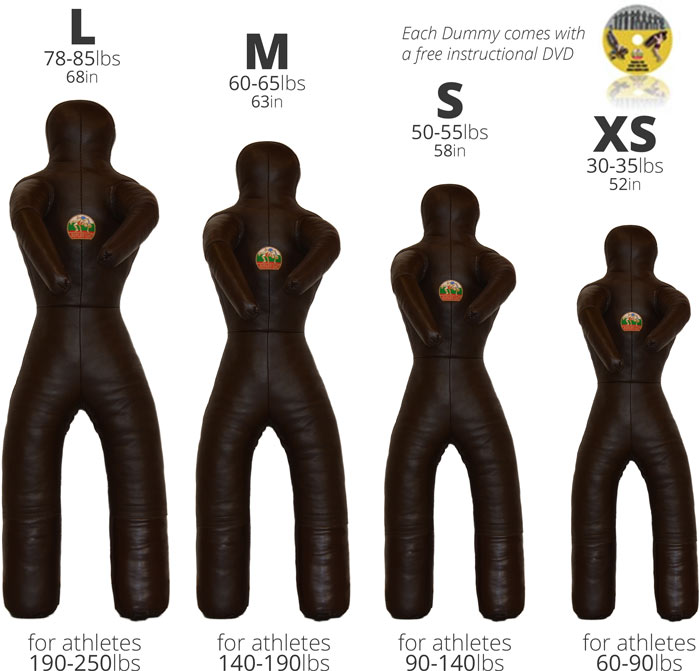Search results for:
Hard-won advice on how to get the most out of rep schemes, your workouts, and your programming. …read more

FREESTYLE DUMMY
FREESTYLE DUMMY – GENUINE LEATHER

FREESTYLE DUMMY – SYNTHETIC LEATHER
Your choice of Genuine brown leather or Artificial black leather (Synthetic) wrestling throwing dummies. The advantage of having the ability to drill leg shots makes the freestyle wrestling dummy a critical tool for all three wrestling styles in the USA. (Free-style, Folk-style and Greco Roman)
The two arms and two legs Suples wrestling dummy is also very beneficial for all the marital arts and Grappling sports. It will benefit their drills on submission holds, kicks, punches and throws. The Freestyle wrestling dummy comes with a training DVD demonstration and recommended work outs and drills from Coach Ivan Ivanov.
DIMENSIONS AND SIZING RECOMENDATIONS
- Extra Small: Weight 33-35 lbs.; Height 52 inches; For athletes 60-90 lbs.
- Small: Weight 50-55 lbs.; Height 58 inches; For athletes 90-140 lbs.
- Medium: Weight 60-65 lbs.; Height 63 inches; For athletes 140-190 lbs.
- Large: Weight 80-85 lbs.; Height 68 inches; For athletes 190-250lbs
SUPLES FREESTYLE WRESTLING DUMMY IN ACTION
SUPLES FREESTYLE WRESTLING DUMMIES – COACH IVANOV’S FAVORITE DRILLS
YOUTH WRESTLERS AT SUPLES TRAINING CENTER IN BOISE IDAHO
Lift heavy and grow, right? Well, it turns out that lifting light weights may make you grow muscle equally as well. …read more

The point of rolling your thoracic spine is usually to get a bit more thoracic extension and help improve your efficiency with overhead lifts. Remember that your shoulder joint only really achieves 165 degrees of overhead flexion and in order to get that big weight overhead we need to get that last 15 degrees from our thoracic spine. Thoracic spine extension is also a major player in shoulder health so we better get this hammered down.
Most people I see rolling their spine tend to just go back and forth for several minutes over their spine. While this is all well and good, I don’t think we actually ever get the effect we’re shooting for, and that is thoracic spine extension.
The main objective of foam rolling is to relax the spine over the roller so we get some mobility in the vertebral joints of the thoracic spine.
If we’re just rolling forward and back, we’re never actually getting any mobility in our thoracic spines. The key is relaxing your spine over the roller in several different segments along the thoracic spine.
I made a video to show you just how to get the job done.
Some more of my favorite t-spine mobility drills
Lastly, I’d follow these drills up with some T-spine stability and shoulder motor control and then hammer away on your technique!
Get after that Tyrannosaurus-spine,
Dan Pope
P.S. If you enjoyed this article then sign up for the newsletter to receive the FREE guide – 10 Idiot Proof Principles to Crossfit Performance and Injury Prevention as well as to keep up to date with new information as it …read more
Combining isometric training with CAT can help even the most stagnant lifter power through to a new PR. …read more
How adding more weight to one side of the body can help you smash even the most stubborn plateaus. …read more

Is this really true though? Is the kipping pullup a much safer variation then the butterfly pullup? Will I tear my shoulder to shreds if I perform butterfly pullups? Honestly I’m not sure. I wanted to do some brainstorming and see if we can come up with some answers.
First things first, what is the butterfly pullup? Who better to instruct you then Mr. Chris Spealler:
And some good old regular kipping pullups with Carl Paoli
I think the first question that comes to mind is, why the hell would I do either? Well, you can obviously do more repetitions of kipping pullups then strict pullups. On top of that, butterfly pullups are faster then kipping pullups. When you put together a workout that requires a lot of pullups in a short period of time, the butterfly pullup fits the bill nicely. So, it makes sense to be butterflying (one of my favorite past times).
The question I want to answer is which one is more stressful on the shoulder, specifically which one is more injurious to the labrum? Great question. First off, how do we injure the labrum in the first place?
Given the complete sparsity of research on shoulder injuries in the crossfit population, we’re just going to have to guess on this one (There is research on the mechanism of injury for other athletes though, so we can atleast draw some conclusions from that realm). There are two ways in which …read more





 Location: Östermalmsgatan 13
Location: Östermalmsgatan 13 Phone: +46 (0) 141-478830
Phone: +46 (0) 141-478830 Email:
Email: 




